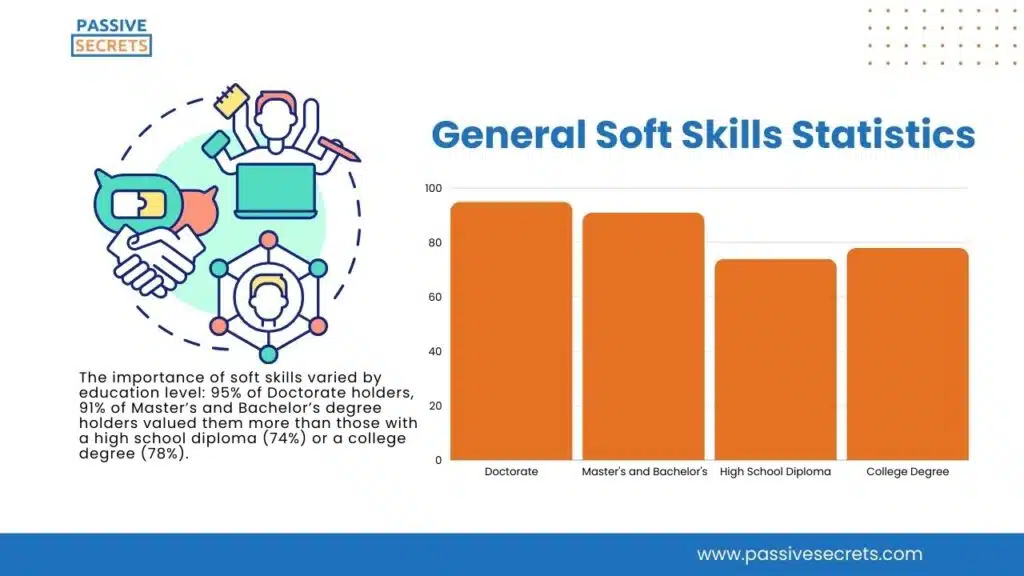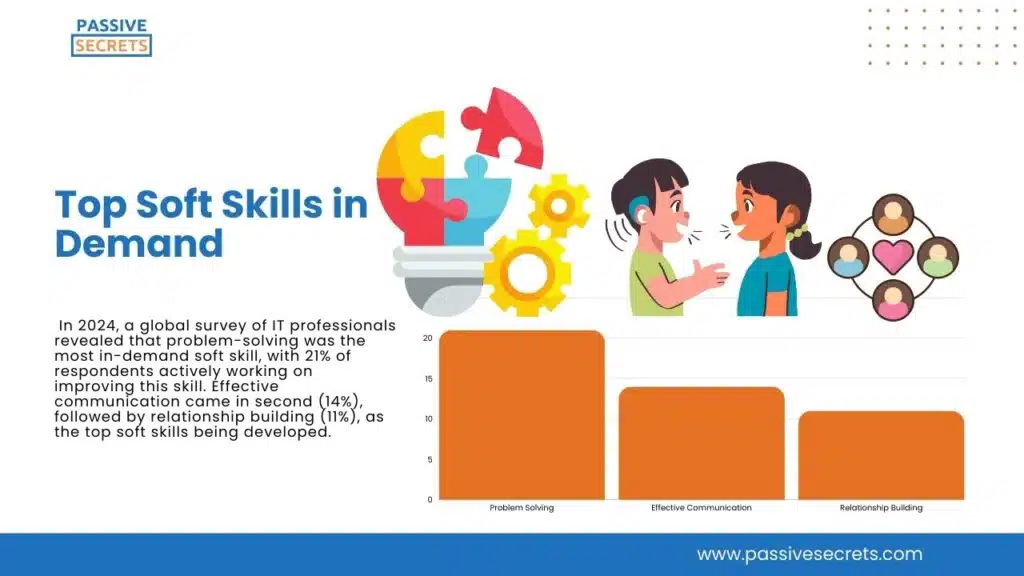
Developing soft skills is just as crucial as acquiring technical skills to succeed in the workplace.
Soft skills, such as communication, teamwork, emotional intelligence, and organizational skills, are essential for effective collaboration, conflict resolution, and creating a positive work environment.
Research shows that soft skills are vital for workplace success, leading to better collaboration, conflict resolution, and a more enjoyable work atmosphere.
In this article, we’ll explore the statistics and trends highlighting the importance of soft skills and why cultivating them is essential for personal and professional growth.
Key Soft Skills Statistics (Editor’s Pick)
- 80% of women acknowledged the importance of soft skills, while 90% of men viewed them as valuable in the workplace.
- The five industries that emphasize the importance of soft skills the most are IT/Telecoms (99%), Finance (89%), Education (89%), HR (88%), and Healthcare (85%).
- Problem-solving was the most in-demand soft skill, with 21% of respondents actively working on improving this skill.
- Soft skills like communication, flexibility, and leadership were identified as the largest skill gaps among recent cybersecurity graduates.
- Durable skills make up 70% of the most in-demand skills listed in job postings. Out of 82 million job postings, 52.5 million demanded durable skills.
- Nearly 29 million job postings in the US required communication as a skill.
- Nearly 63% of individuals who underwent soft skills training reported a positive impact on their performance.
- A single bad hire can set an employer back by 15% to 21% of that employee’s salary.
- The global soft skills training market was worth $29.8 billion in 2023 and is expected to expand to $83.5 billion by 2032, growing at a rate of 12% per year from 2024 to 2032.
- In the U.S., 7% of employees did not receive any soft skills training in the past year. This percentage rose to 13% among small companies with fewer than 50 employees.
- Soft skills were the most sought-after qualities for 91% of management positions, 86% of business operations roles, and 81% of engineering jobs.
General Soft Skills Statistics
1. The importance of soft skills varied by education level: 95% of Doctorate holders, 91% of Master’s and Bachelor’s degree holders valued them more than those with a high school diploma (74%) or a college degree (78%). (source)

2. Opinions varied across industries, with IT, finance, and education sectors seeing a much greater need for soft skills than travel and hospitality. (source)
3. Female employees prioritized soft skills in the following order: communication (26.1%), problem-solving (21.5%), and time management (19.8%). In contrast, male employees ranked them as: problem-solving (21.5%), communication (21.2%), and critical thinking (19.8%). (source)
Why Soft Skills Matter Today
4. 80% of women acknowledged the importance of soft skills, while 90% of men viewed them as valuable in the workplace. (source)
5. 84% of employees and managers think that new hires should have soft skills and show them during the hiring process. (source)
6. Soft skills are seen as important because they can impact hiring decisions (22%), aid in career advancement (18%), and differentiate similar candidates (17%). (source)
7. The five industries that emphasize the importance of soft skills the most are: IT/Telecoms (99%), Finance (89%), Education (89%), HR (88%), and Healthcare (85%). (source)
8. 90% of companies with over 500 employees consider soft skills to be the most important factor. (source)
9. Soft skills are deemed crucial for U.S employees because they can be a deciding factor in hiring (22%), are vital for professional growth (18%), and can set apart similarly qualified candidates (17%). (source)
Top Soft Skills in Demand
10. A 2023 survey found that 58% of security professionals considered communication skills, such as listening and speaking, to be the most important soft skills, while only 17% believed that honesty was a crucial trait for security professionals. (source)
11. An analysis of Dutch job vacancies revealed that ‘enthusiasm’ is a highly sought-after soft skill, mentioned in about 20% of postings, while creativity appeared in just over three percent. (source)
12. In 2024, a global survey of IT professionals revealed that problem-solving was the most in-demand soft skill, with 21% of respondents actively working on improving this skill. Effective communication came in second (14%), followed by relationship building (11%), as the top soft skills being developed. (source)

13. In 2023, soft skills like communication, flexibility, and leadership were identified as the largest skill gaps among recent cybersecurity graduates. (source)
14. About 90% of UK employers now consider soft skills crucial, with communication, leadership, and problem-solving emerging as the most sought-after skills in the UK job market. (source)
15. In 2022, soft skills appeared in 78% of job postings worldwide in the past three months. (source)
16. 45% of all LinkedIn Premium job postings in the past three months highlighted the importance of communication skills. (source)
17. Durable skills make up 70% of the most in-demand skills listed in job postings. Out of 82 million job postings, 52.5 million demanded durable skills. (source)
18. Most management (91%), business operations (86%), and engineering (81%) jobs require at least one durable skill, whereas jobs at higher risk of automation, like transportation and material moving, have a much lower demand (22%) for these skills. (source)
19. Nearly 29 million job postings in the US required Communications as a skill. (source)
20. The top 5 Durable Skills (soft skills) were requested 3.8 times more frequently than the top 5 Hard Skills (technical skills) in U.S job postings. (source)
Impact of Soft Skills on Employment and Career Growth
21. Nearly 63% of individuals who underwent soft skills training reported a positive impact on their performance. (source)
22. A Harvard University study found that up to 80% of an individual’s career achievements are influenced by soft skills, with hard skills contributing only 20%. (source)
23. Studies suggest that soft skills play a significantly larger role in long-term job success, contributing an estimated 75% to 85%. (source)
24. A survey of 400 large companies, each with 100,000 employees, revealed a staggering average annual loss of $62.4 million per company due to poor employee/management communication. (source)
25. Organizations that prioritize soft skills in their workforce are likely to see a 26% increase in revenue growth, with 85% of job success attributed to these skills. (source)
26. 78% of corporate workers said their commitment to their organizations declined when faced with toxic behavior, while 66% reported a decrease in their performance. (source)
27. A single bad hire can set an employer back by 15% to 21% of that employee’s salary. (source)
28. In retail, where turnover is high (60-70%), soft skill matching is key to reducing churn and boosting satisfaction. (source)
Statistics on Soft Skill Training Investment
29. The global soft skills training market was worth $29.8 billion in 2023 and is expected to expand to $83.5 billion by 2032, growing at a rate of 12% per year from 2024 to 2032. (source)
30. The soft skills training market is projected to grow by USD 315.6 million, with a compound annual growth rate (CAGR) of 50.98% from 2023 to 2028. (source)
31. In a survey, employees received soft skills training via in-person (28%), virtual instructor-led (20%), virtual self-directed (20%), and hybrid (30%), with in-person training rated the highest. (source)
32. Companies that emphasize soft skills in their training and hiring processes benefit from a 30% higher employee retention rate and a 50% increase in employee engagement. (source)
33. The most frequently offered soft skill training opportunities were in communication (35%) and problem-solving (35%), as these were universally recognized as essential skills for employees to have. (source)
34. In the U.S., 7% of employees did not receive any soft skills training in the past year. This percentage rose to 13% among small companies with fewer than 50 employees. (source)
35. Soft skills like communication, emotional intelligence, adaptability, and teamwork boost workplace culture and engagement. In-person training for these skills has a high satisfaction rate of 76%. (source)
Soft Skills vs. Hard Skills: Employer Priorities
36. Soft skills are vital in hiring, with 92% of talent professionals regard them as equally as important or even more important than hard skills. Additionally, 80% believe they are increasingly essential for company success. (source)
37. 85% of career success is attributed to strong interpersonal and soft skills, while hard skills, such as technical abilities and knowledge, account for only 15%. (source)
38. Soft skills were the most sought-after qualities for 91% of management positions, 86% of business operations roles, and 81% of engineering jobs. (source)
39. More than two-thirds (67%) of employers prioritize soft skills over educational qualifications when hiring, according to research by Indeed. (source)
40. Although soft skills are rated more highly, over half (58%) of employers still consider A-level and BTEC results when screening candidates, with 53% acknowledging their importance beyond entry-level positions. (source)
Future Projections for Soft Skills Demand
41. 71% of employees believe soft skills will be as important or more important in the future. In contrast, only 3% think AI will replace the need for soft skills in the workplace. (source)
42. By 2030, nearly two-thirds of all jobs (63%) will require soft skills, a significant increase from 53% in 2000. This indicates a growing shift towards soft-skills-intensive occupations. (source)
Trends In Soft Skills Acquisition Training
1. Reskilling and Upskilling
Reskilling and upskilling are key trends in soft skills development driven by rapid technological change.
Reskilling teaches employees new skills to transition into different roles as certain tasks become obsolete, focusing on adaptability, problem-solving, and teamwork.
Upskilling deepens employees’ expertise within their current roles, emphasizing advanced communication, leadership, and emotional intelligence.
Both approaches respond to the rising importance of soft skills, building a workforce that is technically proficient and agile in adapting to change.
2. Immersive learning through VRs and ARs
Immersive learning through Virtual Reality (VR) and Augmented Reality (AR) is a growing trend in soft skill training.
Virtual realities (VRs) create realistic scenarios for practicing soft skills, such as giving presentations or handling difficult conversations. These technologies help learners stay focused and motivated by providing interactive experiences for them.
Users get to receive immediate feedback on their performance which also allows for immediate changes to be made. Additionally, VR and AR training can reach remote employees, making soft skills training more accessible to a wider range of staff.
These lasting experiences tend to leave more impact on employees and ensure memory retention compared to traditional training methods.
3. Peer-to-peer learning
Peer-to-peer learning is an important trend in soft skill training. It involves employees learning from each other rather than just from instructors.
This approach fosters collaboration and communication among team members.
Employees can share their experiences and insights, making the learning process more relatable and exciting.
This form of soft skill training also encourages active participation among employees and leads to better retention of skills. Peer feedback helps individuals identify strengths and areas that need improvements.
4. Data-driven learning approach
Data-driven learning approach is becoming a key trend in soft skill training. This method of soft skill acquisition training uses data to identify skill gaps and training needs within an organization.
The proper analysis of important performance metrics can help organizations tailor their training programs to address the specific needs of different employees and aid improvements.
This ensures that resources are used effectively and every training program is relevant to the employees involved. Data-driven insights also help measure the impact of training on performance, allowing for the continuous growth of an organization and effective soft skill development.
5. AI personalized learning
The increased use of artificial intelligence to create customized and personalized learning experiences for employees has been discovered to significantly influence soft skill training.
Artificial intelligence (AI) can be used to analyze employees’ learning preferences and also progress. This method uses artificial intelligence to tailor learning experiences to each employee’s unique needs.
This personalized approach helps employees engage more effectively with the training material and allows them to learn at their own pace. Additionally, AI can provide instant feedback and recommendations for further improvement.
Conclusion
Soft skills are crucial in corporate organizations, enhancing communication, teamwork, and problem-solving. Employers value these skills as they foster a productive and harmonious workplace.
Developing soft skills leads to success in jobs, better relationships, and improved overall well-being. By practicing soft skills, we can connect with others more effectively, achieve common goals, and make our personal and professional lives more efficient.
FAQs

Other Related Statistics You Should Know:
- Incredible Women in Leadership Statistics: Insights into Global Gender Representation
- Billionaire Statistics: Surprising Insights About The World’s Wealthiest
- 89 Business Loan Statistics Every Entrepreneur Should Know
- 70+ AI in Education Statistics That Prove the Future Is Already Here
- 95+ Fascinating Gift Industry Statistics to Surprise and Delight
- Top Business Coaching Statistics & Trends Every Leader Should Know
- How Much Are People Saving? Key Personal Savings Statistics Explained
- 40+ Useful Procrastination Statistics To Help You
- 90 Amazing Millionaire Statistics & Facts You Dare Not Miss
- 50+ Latest Life Coaching Statistics And Huge Trends
- 30+ Useful Real Estate Photography Statistics and Trends You Need to Know
- Data-Driven Decision-Making Statistics: Trends, Benefits & Challenges
- 54 Incredible Goal-Setting Statistics To Help You
- 45+ Interesting Communication Skills Statistics & Huge Trends
- Body Language Statistics & Fun Facts To Boost Your Communication Skills
- 35 Interesting Public Speaking Fear Statistics & Fun Facts
- 25+ Most Interesting Emotional Intelligence Statistics & Fun Facts

